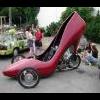Search the Community
Showing results for tags 'approach'.
-
Like that also can huh ? Initial letter by a member of the public: Inconsistent parking enforcement From Yolanda Chin Tsu-Li 04:45 AM Oct 31, 2012 I am concerned about the inconsistencies in enforcing traffic laws in Braddell Heights, where a string of restaurants were granted permits a few years ago to operate, along Jalan Riang, despite the absence of public car parks in the neighbourhood. Diners and residents have since been competing for scarce parking, leading to congestions and scuffles. As a result, the Land Transport Authority (LTA) has been regularly monitoring the neighbourhood to enforce traffic rules in the interest of safety. I had brought the worsening traffic and parking situation to the attention of Member of Parliament Seah Kian Peng in the past. He said that it was not within his jurisdiction to solve the problem, as it was legal for the restaurants to operate and for the LTA to enforce traffic rules. I was advised to park at less congested roads and walk, should no parking be available near my home. I agree that it is not within his jurisdiction to instruct LTA officers how to do their job. Then, on Oct 20, the grassroots organisation threw a party, attended by Mr Seah, at the park along Jalan Riang. As usual, many cars were parked illegally, and an LTA officer arrived that afternoon to enforce the law. But he left without booking any drivers. I wish to clarify if the officer knew the implications of his dereliction of duties on public safety, and if so, why he still chose to leave. I reported the incident to the LTA and was assured that I would hear from an officer who would be assigned to investigate. I have yet to hear from the LTA since. Follow-up letter by MP: Give and take, not 'principled' approach From Seah Kian Peng Member of Parliament, Marine Parade GRC 04:45 AM Nov 02, 2012 Parking issues in private estates are common. I have helped mediate these and have conducted various dialogues with my residents in private estates for various streets. They are time consuming and require effort and cooperation by all parties. Ms Yolanda Chin, who lives near the eateries and wrote "Inconsistent parking enforcement" (Oct 31), had approached me previously about noise and traffic issues. I asked the eateries to cooperate and ensure their patrons observe the rules. I also asked for enforcement to be stepped up during busy periods, when there was indiscriminate parking in the area. Residents have told me that things have since improved. The garden party on the day in question, from 4pm to 6pm on a Saturday, was to celebrate the completion of an estate upgrading project in Ms Chin's estate. All its residents were invited. As I was driving there, I saw an enforcement officer about to book some cars; I stopped and told him that many residents would be at the party and, unless their cars were obstructing traffic, to apply a light touch and not issue any summons. This was not the peak period, the cars were parked in an orderly manner and I do not think there were any public safety issues as Ms Chin stated. I am an advocate that everyone, resident or not, should be reasonable and considerate, with a give and take approach. All are neighbours there, and when one starts to adopt an uncompromising or unneighbourly approach, such behaviour normally spreads. It then becomes a lose-lose situation. Most importantly, it destroys the neighbourly spirit in any community. There will always be some residents who insist that there be constant enforcement, regardless of circumstances. I am against such a "principled" approach for such matters. I take heart that in two streets in my estate where such disputes used to occur, things have improved following a series of mediation and consensus building among residents. They have adopted their own ground rules and determination to solve matters internally and to call the enforcement agency only as a last resort. It has worked well, and the neighbourhood is more peaceful and cordial now. Back to the garden party: As it was raining heavily from 5.30pm, most residents and cars had already left by then. I hope this letter puts things in the right perspective.
-
The market-driven pricing approach taken by the government has contributed to cost in Singapore rising so rapidly, beyond the rate of growth of incomes of Singaporeans and beyond the rate of growth of company profits, Member of Parliament (MP) for the Ang Mo Kio GRC Inderjit Singh said on Tuesday. He noted that the government has often been quick to increase its various charges, allowing costs to escalate, immediately upon a recovery from an economic recession. 'Each time this happens, we bring the cost base higher without having an opportunity for cost reductions. This has led costs to unrealistically increase faster and more than profit and income growth,' Mr Singh said. An example was in 2008, when property prices rose despite the recession because of 'liberal policies on capital inflows'. 'While the government should not interfere in the private market except to curb speculation, it could have done a lot for the HDB market had it not pursued market driven pricing,' Mr Singh said. 'Also market driven pricing has created huge cost burdens and will potentially edge out many of our SMEs because of squeezed margins,' he added.
-
Inspired by another thread. Let's say you want to approach a girl in a public place and chat her up, how would you go about doing it? Can the love sexperts share some insights?
-
Just would like to find out if any of you guys did as above? For me, it does. Use to drove a 140BHP car and push like no body business, just to fully extract the 140 ponies on every occasions.... [hur] However, after changed to this current ride, I hardly even used more than 70% of the car power.... :blink: Any comment?
-
Hi, posting on behalf of my friend, she understands the stock market and is really keen to trade in the NYSE. But she is not sure which local trading firm is better in terms of charges and reliability. Sorry, i not keen on trading so if what i type here does not make sense, kindly advise. Thanks
-
Spinal Cooling Key To Everett's Recovery BUFFALO, N.Y., Sept. 13, 2007 -------------------------------------------------------------------------------- (CBS/AP) Doctors are following the playbook in treating Buffalo Bills football player Kevin Everett's severe spinal cord injury except in one notable regard: pumping icy cold saline into his veins to try to prevent further damage. Although the treatment is experimental, it is more science than science fiction, and also is being tried on stroke and brain injury patients. Everett's prognosis remains uncertain. His doctors were encouraged by signs on Tuesday that he could move his legs and arms - a day after saying he stood little chance of making a full recovery. They also have said that his spinal cord was intact rather than severed - a very good sign. Doctors say that it is far too soon to know whether he will be left with any paralysis or its extent. "Walking out of this hospital is not a realistic goal, but walking may be," Dr. Andrew Cappuccino, the team's orthopedic surgeon, said at a news conference in Buffalo on Wednesday. "We have every hope and anticipation he will walk," said Dr. Barth Green, chairman of the Department of Neurological Surgery at the University of Miami's Miller School of Medicine, who has been consulting with doctors in Buffalo. The procedure, while experimental, is not new and, according to Dr. Green, is based on years of laboratory work, capped by the quick, collective efforts of physicians and health professionals who attended Everett once he fell. The reason Everett's situation has improved, Dr. Green suggested, was because the cooling has been applied so quickly: "It's definitely the first time it's ever been done so early after an injury. "He was handled properly," Dr. Green told CBS' The Early Show. "He was rushed into an ambulance, properly positioned. They dropped his body temperature immediately 15 minutes after the injury, which is a world record. And all that came together with good surgery and good care." Everett suffered a fracture and dislocation of his spinal cord in the neck area during a game Sunday night against the Denver Broncos. Watching it on television from home was Dr. W. Dalton Dietrich, scientific director for the Miami Project, a spinal cord program affiliated with the Miller School of Medicine. The program is among several in the United States that has led research into moderate hypothermia, or cooling the body a few degrees to try to limit swelling, inflammation and the cascade of events and chemicals that cause further damage after an initial neurological injury. Dietrich sent an urgent e-mail to fellow neurosurgeon Dr. Green, who knows Buffalo Bills owner Ralph Wilson. Who did what next is unclear, but doctors say Everett received the experimental cooling therapy in the ambulance, even before X-rays and other tests could show the extent of his injury and the treatment he would need. The goal of the treatment is "to cool the tissue a few degrees to reduce its need for oxygen and to reduce its metabolic rate" and limit secondary damage from chemicals the body releases after the initial injury, said Dr. Elad Levy, a University of Buffalo neurosurgeon who treated Everett. On Monday, as Everett's temperature began to rise, doctors decided to try cooling his body again, using a slightly different system. This time, a hollow tube called a catheter was inserted into the femoral vein in the leg near the groin. Cold saline was circulated inside the catheter, indirectly cooling the blood as it flowed through the vein. "We did this here at the University of Pittsburgh in the '70s," but with a different method of threading a catheter directly over the spinal cord, Maroon said. The treatment had to be done within three hours of injury to have any benefit and was extremely cumbersome, he said. For that and other reasons, it was largely abandoned until recently, when doctors have resumed testing it through different cooling methods for stroke and brain injury patients. "There's no reason around the world we don't give patients this treatment where they are," Dr. Green said, "whether they have a heart attack or spinal cord injury, because the paramedics are there within minutes so we have the opportunity." "There are compelling reasons why one might want to try it" in a case like this, said Dr. Gary Steinberg, chairman of neurosurgery at Stanford University. He had no role in Everett's case but has tested the body cooling treatment. "Not a lot is known about it for spinal cord injury," said Steinberg, where it mostly is done in some stroke and head injury cases under an experimental protocol. Other aspects of Everett's care are more routine. He received large intravenous doses of methylprednisolone, a steroid to limit inflammation and swelling, and had decompression surgery to relieve pressure on his spinal cord. Doctors initially operated from the front of his neck, removing the injured disk and bone impinging on the spinal cord, and realigned it. They filled the space where the disk had been with a bone graft - whether from a cadaver or his hip isn't known - and put in a titanium plate to stabilize the neck area. Surgeons then turned him over and operated from the back of his neck, fusing the vertebrae above and below the fracture, and putting in four screws and two small rods. Long-term results from such operations can vary widely, said Maroon, the Steelers' surgeon who published a paper in the April issue of Journal of Neurosurgery on this topic. He has operated on about 30 athletes. But whatever the extent of Everett's recovery, a return to his career on the field is not likely, said Dr. Joseph Maroon, team neurosurgeon for the Pittsburgh Steelers and a University of Pittsburgh Medical Center specialist who was consulted on Everett's case. "If he ever does regain function, no neurosurgeon would ever permit him to play football," Maroon said. On Wednesday, Everett was successfully removed from the respirator though doctors say it could be a struggle to keep him breathing on his own. A stroke and blood clots in his legs are other possible complications they are trying to prevent. He showed more ability to move his legs and a little more in his arms, but has no movement or function at all of his hands. He is getting nourishment from a feeding tube, and his mother is at his side. "She understands that this is a life-changing event," and that "the story will change over months to years," said Dr. Kevin Gibbons, another University of Buffalo neurosurgeon who has been treating Everett. AP Medical Writer Marilynn Marchione contributed to this report




